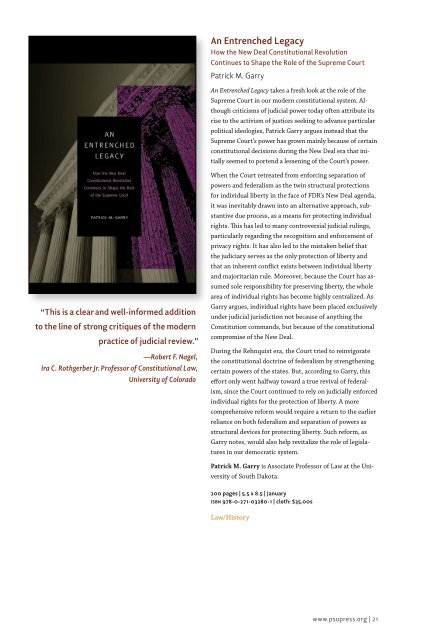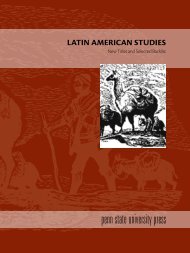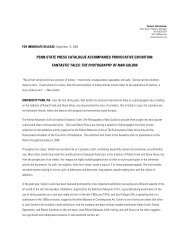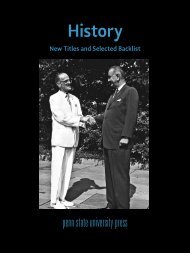Philosophy, Black Film, Film NoirDan Florythe larger crimes of White America itself.”“The darkness of film noirwas always meant to illuminateas well as reflectthe shadows of the meanstreets of Gangland USA.Now, in this fascinatingsynthesis of philosophy,film studies, and criticalrace theory, Dan Floryreveals to us the significanceof the deeper blacknessof African-Americannoir—a light ‘doubly’black aimed at exposing—Charles W. Mills,Northwestern <strong>University</strong>,and author of The Racial ContractIn the past two decades, African American filmmakerslike Spike Lee have made significant contributions tothe dialogue about race in the United <strong>State</strong>s by adaptingtechniques from classic film noir to black American cinema.This book is the first to examine these artistic innovationsin detail from a philosophical perspective informed by bothcognitive film theory and critical race theory.Dan Flory explores the techniques and themes that areused in black film noir to orchestrate the audience’semotions of sympathy and empathy felt toward morallycomplex characters whom people might not typicallyfind appealing in real life, such as thugs, drug dealers, ormurderers. Using an approach that combines the cognitiveinsights of theorists like David Bordwell, Noël Carroll, andMurray Smith with the reflective Wittgensteinian methodsfor considering film employed by Stanley Cavell, StephenMulhall, and William Rothman, Flory shows how thesefilms scrutinize the <strong>state</strong> of race in America, induce theirviewers to do so as well, and illuminate the ways in whichcategories of race have defined and continue to direct muchof our vision of the moral self and what counts as appropriatemoral sensibility.Dan Flory is Associate Professor of Philosophy at Montana<strong>State</strong> <strong>University</strong>.408 pages | 35 illustrations | 6 x 9 | Juneisbn 978-0-271-03344-0 | cloth: $65.00sPhilosophy and Rhetoric in DialogueRedrawing Their Intellectual LandscapeEdited by Gerard A. HauserPhilosophy and Rhetoric,one of Penn <strong>State</strong> <strong>Press</strong>’slongest-running journals,was conceived at a timeof immense philosophicalupheaval: rhetoric as afield of study—first dismissedby Descartes—wasbeing reexamined afterdecades of neglect. Now,nearly forty years later,Philosophy and Rhetoriccontinues to hold pride ofplace in this reinvigorateddiscipline. The brainchild of Penn <strong>State</strong> professors CarrollArnold and Henry Johnstone, Philosophy and Rhetoricboasts work from dozens of international luminariesfrom a broad spectrum of specializations. To commemoratethe fortieth year of publication, current series editorGerard Hauser assembled a volume of the journal’s mostnoteworthy articles, beginning with Henry Johnstone’sgem of an essay underscoring the essential relationshipbetween the art of rhetoric and philosophy. Donald Vereneelaborates that initial thesis and suggests that rhetoric andphilosophy are not distinct entities in conversation, butinstead that rhetoric provides a forum in which philosophycan exist. Jean Goodwin looks at the theory in terms of ateacher/student relationship, and Barbara Biesecker looksat how governments in the war on terror employ rhetoricto manipulate the social consciousness. A concludingarticle by Carroll Arnold casts rhetoric as a dramatic deviceessential to establishing personal sovereignty. During itsforty years, Hauser writes, the journal “radically altered therelationship between philosophy and rhetoric from irreconcilableantagonists to interlocutors in a shared inquiry intothe constitutive powers of discourse.” This series of essaysbrilliantly traces the arc of that accomplishment.Gerard A. Hauser is Professor of Communications at the<strong>University</strong> of Colorado at Boulder.188 pages | 6 x 9 | Februaryisbn 978-0-271-02768-5 | paper: $25.00sPhilosophyPhilosophy/Film Studies20 | <strong>penn</strong> <strong>state</strong> <strong>university</strong> <strong>press</strong>
An Entrenched LegacyHow the New Deal Constitutional RevolutionContinues to Shape the Role of the Supreme CourtPatrick M. GarryAn Entrenched Legacy takes a fresh look at the role of theSupreme Court in our modern constitutional system. Althoughcriticisms of judicial power today often attribute itsrise to the activism of justices seeking to advance particularpolitical ideologies, Patrick Garry argues instead that theSupreme Court’s power has grown mainly because of certainconstitutional decisions during the New Deal era that initiallyseemed to portend a lessening of the Court’s power.“This is a clear and well-informed additionto the line of strong critiques of the modernpractice of judicial review.”—Robert F. Nagel,Ira C. Rothgerber Jr. Professor of Constitutional Law,<strong>University</strong> of ColoradoWhen the Court retreated from enforcing separation ofpowers and federalism as the twin structural protectionsfor individual liberty in the face of FDR’s New Deal agenda,it was inevitably drawn into an alternative approach, substantivedue process, as a means for protecting individualrights. This has led to many controversial judicial rulings,particularly regarding the recognition and enforcement ofprivacy rights. It has also led to the mistaken belief thatthe judiciary serves as the only protection of liberty andthat an inherent conflict exists between individual libertyand majoritarian rule. Moreover, because the Court has assumedsole responsibility for preserving liberty, the wholearea of individual rights has become highly centralized. AsGarry argues, individual rights have been placed exclusivelyunder judicial jurisdiction not because of anything theConstitution commands, but because of the constitutionalcompromise of the New Deal.During the Rehnquist era, the Court tried to reinvigoratethe constitutional doctrine of federalism by strengtheningcertain powers of the <strong>state</strong>s. But, according to Garry, thiseffort only went halfway toward a true revival of federalism,since the Court continued to rely on judicially enforcedindividual rights for the protection of liberty. A morecomprehensive reform would require a return to the earlierreliance on both federalism and separation of powers asstructural devices for protecting liberty. Such reform, asGarry notes, would also help revitalize the role of legislaturesin our democratic system.Patrick M. Garry is Associate Professor of Law at the <strong>University</strong>of South Dakota.200 pages | 5.5 x 8.5 | Januaryisbn 978-0-271-03280-1 | cloth: $35.00sLaw/Historywww.psu<strong>press</strong>.org | 21
















